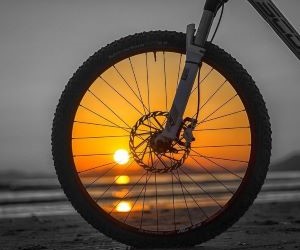Learn how to deal with punctures on long rides with prevention tips, repair techniques, and smart gear choices to keep rolling without stress.
WHICH NEW AERO ROAD BIKES ARE DOMINATING SPEED TESTS IN 2025?
The aero road bike market in 2025 is more competitive than ever, with brands pushing the limits of aerodynamics, integration, and performance. Professional cycling teams and independent labs alike conduct speed tests that measure watts saved, stiffness-to-weight ratios, and real-world handling. This article examines which bikes dominate current benchmarks, how manufacturers balance UCI regulations with innovation, and what these advancements mean for everyday riders. The findings reveal not just marginal gains, but a transformative era in aero design.

The evolution of aero road bikes
Aero road bikes emerged in the early 2010s as niche machines for sprinters and time trialists. Today, they have evolved into all-rounders that blend lightweight climbing ability with aerodynamic profiles. By 2025, almost every major manufacturer offers a flagship aero road bike designed not only to save watts but also to deliver stiffness, comfort, and handling stability. The arms race is fueled by WorldTour demands, where even a one-second gain can decide Grand Tour stages.
Key innovations shaping the field
The 2025 generation integrates cutting-edge CFD (computational fluid dynamics), wind tunnel testing, and real-world sensor data. Bikes now feature narrower tube profiles, fully internal cable routing, and proprietary cockpit systems. Frame geometry balances aggressive aero positioning with rider comfort for long-distance racing.
Deeper tube sections optimized within UCI’s 8:1 rule
Integrated handlebars and stems for drag reduction
Hidden seatpost clamps and stealth cable routing
Carbon layups tuned for stiffness and vibration control
These features are no longer exclusive to pro riders. Consumer models mirror pro-level frames, with only component group choices differentiating price tiers. Thus, riders at all levels benefit from trickle-down innovations born in the pro peloton.
Testing methodologies
Independent speed tests typically evaluate aerodynamic drag at 45 km/h, stiffness at the bottom bracket and head tube, and total system weight. Increasingly, real-world rolling resistance and yaw-angle performance (crosswind stability) are included. These factors matter because riders rarely face wind head-on, making handling as important as pure speed.
Top performers in 2025 speed tests
Several bikes consistently dominate independent benchmarks in 2025. While marginal differences exist, certain models have emerged as clear leaders in aerodynamic efficiency, stiffness, and real-world rideability. Teams in the WorldTour have already adopted many of these machines, providing validation under the harshest racing conditions.
Specialized Tarmac SL8
The SL8 continues Specialized’s tradition of pushing aero boundaries while maintaining low weight. With a frame weighing under 700g and an aggressive aero profile, it tested as one of the fastest in both wind tunnel and rolling road scenarios. Specialized’s “FreeFoil” shaping technology ensures optimized drag reduction across yaw angles, making it equally effective in solo breakaways and bunch sprints.
Cervélo S5
Redesigned for 2025, the Cervélo S5 has become a sprinting weapon of choice. Its V-shaped stem and handlebar integration deliver unmatched stiffness, while the deep head tube profile excels in straight-line speed. Tested against rivals, it saved 10–15 watts at 45 km/h compared to mid-tier aero bikes. This makes it a favorite in flat stages and criteriums.
Trek Madone Gen 8
Trek’s latest Madone features its IsoFlow cutout behind the seat tube, which reduces drag while improving compliance. Independent testers report the Madone as one of the most stable in crosswinds, a critical factor for real-world riding. Its balance of speed and comfort has made it a go-to choice for GC contenders seeking an all-around aero solution.
Specialized Tarmac SL8 – ultra-light with aero gains
Cervélo S5 – benchmark sprinting machine
Trek Madone Gen 8 – aerodynamic stability and compliance
Canyon Aeroad CFR – value performance powerhouse
Pinarello Dogma F Aero – Grand Tour proven design
Canyon Aeroad CFR and Pinarello Dogma F Aero
The Canyon Aeroad CFR continues to impress with its price-to-performance ratio. Its adjustable cockpit and aggressive geometry make it popular with both pros and amateurs. Meanwhile, the Pinarello Dogma F Aero blends Italian design with empirical wind-tunnel data, excelling in both aesthetics and performance. Used by WorldTour winners, it remains one of the most versatile aero bikes on the market.
Implications for riders and the market
The dominance of aero road bikes in speed tests is reshaping cycling’s performance landscape. Where once climbers favored ultralight frames, the 2025 generation of aero bikes now provides competitive climbing efficiency while excelling on flats and descents. This convergence has led to a shift in rider preferences and team strategies, with more pros using aero bikes as their all-around machines.
Accessibility for amateurs
While flagship models remain costly, mid-tier builds now feature the same aerodynamic frames with more affordable components. Riders can access the same frames tested by pros without paying for electronic groupsets or carbon wheel upgrades. This democratization of aero performance is one of the most significant trends in the market.
Aero bikes now double as all-rounders
Mid-tier builds offer pro-level frames
Consumer demand drives integration and simplicity
Market trends shift toward complete aero ecosystems
Beyond performance, aesthetics and integration now play major roles in consumer choice. Fully hidden cables, one-piece cockpits, and sleek silhouettes have become status symbols, reflecting the blend of performance and lifestyle appeal.
Future of aero innovation
Looking ahead, expect further advances in material science, real-world aero testing with on-bike sensors, and integration of electronic shifting with aerodynamic optimization. The line between time trial bikes and aero road bikes will continue to blur, with the UCI’s regulatory framework guiding what’s possible. As the pursuit of marginal gains intensifies, the 2025 class of aero bikes sets the stage for the next leap forward.
In summary, the latest aero road bikes are not just dominating speed tests—they are redefining what an all-purpose race machine looks like. From Specialized to Trek, Cervélo to Canyon, the leaders of 2025 have made speed more accessible, versatile, and desirable than ever.
YOU MAY ALSO BE INTERESTED






